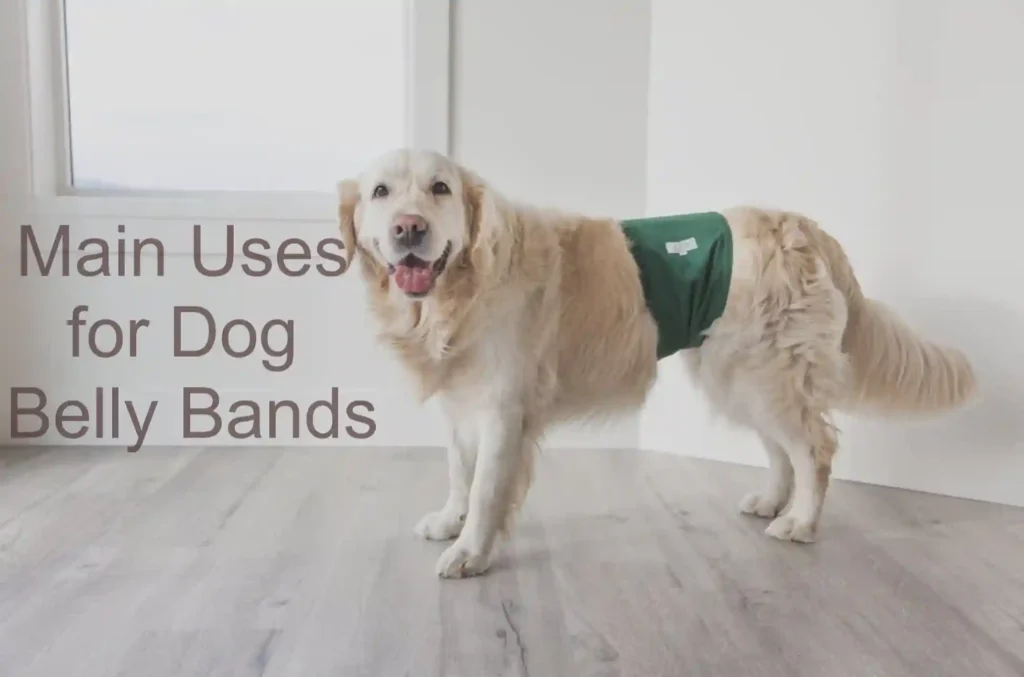Dog owners face many challenges. One big problem is when dogs pee inside the house. Male dogs often mark their territory. They lift their legs on furniture and walls. This makes owners upset and frustrated.
Belly bands are a simple solution. They wrap around your dog’s waist. The band catches pee before it hits your floor. Many dog owners use them every day. But are they really good for your pet?
This guide covers the PROS AND CONS OF BELLY BANDS FOR DOGS. You will learn everything about these products. We explain when to use them and when to avoid them.
What Are Belly Bands for Dogs?
A belly band is like a cloth diaper for male dogs. It goes around their belly and covers their private parts. The band has a soft pad inside. This pad soaks up pee when accidents happen.
Most belly bands use velcro to close. Some have snaps or buttons. They come in different sizes and colors. You can wash them in your washing machine.
How Do Belly Bands Work?
The process is very simple:
- Your dog wears the band around his waist
- When he tries to pee, the pad catches it
- The pee stays in the band instead of on your floor
- You change the wet pad for a clean one
- Your house stays dry and clean
Who Makes Belly Bands?
Many pet companies sell belly bands. You can buy them at pet stores. Online shops also sell them. Some people make their own at home. The price ranges from cheap to expensive.
Main Uses for Dog Belly Bands

Dog owners use belly bands for different reasons. Each situation needs a different approach. Here are the most common uses.
Stopping Territory Marking
Male dogs love to mark their space. They pee on walls, furniture, and corners. This behavior drives owners crazy. Belly bands stop the pee from reaching surfaces.
Dogs still try to mark when wearing bands. But the pee goes into the pad. Your house stays clean. The dog learns that marking does not work anymore.
Common marking situations include:
- New dogs in the house
- Visitors coming over
- Moving to a new home
- Other male dogs nearby
- Stress and anxiety
- Unneutered males
House Training Help
Puppies need time to learn bathroom rules. Young dogs cannot hold their pee very long. Accidents happen during training. Belly bands protect your floors during this time.
Adult dogs sometimes forget their training. Rescue dogs may not know house rules. Belly bands give you time to teach them properly.
Training situations where bands help:
- Puppies under 6 months old
- Newly adopted dogs
- Dogs from shelters
- Moving to a new house
- Changes in routine
- Stress from new situations
Medical Problems
Some dogs cannot control their pee. This happens due to health issues. Old dogs often have weak bladders. Surgery can cause temporary problems. Medicine might make dogs pee more.
Belly bands help during medical treatment. They keep dogs comfortable and clean. Your house stays protected while your dog gets better.
Medical reasons for belly bands:
- Weak bladder muscles
- Nerve damage
- After surgery
- Side effects from pills
- Old age problems
- Diabetes
Excitement Peeing
Young dogs often pee when excited. They cannot control themselves during play. Guests make them so happy they have accidents. Belly bands catch this pee before it hits the floor.
Some dogs pee when scared. Others do it when meeting new people. This is normal behavior that usually goes away with age.
PROS AND CONS OF BELLY BANDS FOR DOGS: The Good Parts
Belly bands offer many benefits for dog owners. They solve problems quickly and easily. Here are the main advantages.
Easy to Put On
Belly bands are simple to use. You wrap them around your dog like a belt. Most dogs do not mind wearing them. The process takes less than one minute.
Steps to put on a belly band:
- Hold the band open
- Wrap it around your dog’s waist
- Make sure it covers the right area
- Close the velcro or snaps
- Check that it fits snugly
- Let your dog walk around
Saves Your House
The biggest benefit is protecting your home. No more pee stains on carpets. No more smelly spots on walls. Your furniture stays clean and dry.
This saves money on cleaning. You do not need expensive carpet cleaners. Professional cleaning services cost a lot. Belly bands prevent this expense.
House protection benefits:
- Clean floors and carpets
- No bad smells
- Less cleaning work
- Saves money
- Protects expensive furniture
- Keeps guests happy
Works Right Away
Belly bands give instant results. You put one on your dog and the problem stops. No waiting for training to work. No hoping your dog will learn.
This quick fix reduces stress for everyone. You stop worrying about accidents. Your dog feels less pressure. The whole family is happier.
Does Not Hurt Dogs
Good quality belly bands are comfortable. Dogs can walk, run, and play normally. The soft materials feel nice against their skin. Most dogs forget they are wearing them.
Comfort features include:
- Soft fabric materials
- Breathable design
- Flexible fit
- Light weight
- Easy movement
- No tight squeezing
Costs Less Than Other Solutions
Belly bands are cheaper than many alternatives. Professional dog training costs hundreds of dollars. Carpet replacement is very expensive. Belly bands cost much less.
You can use the same band many times. Just wash it when dirty. This makes it a smart money choice for most families.
Cost benefits:
- Low purchase price
- Can use many times
- Saves cleaning costs
- Prevents damage expenses
- Less than trainer fees
- Washable and reusable
Good for Travel
Belly bands work great when traveling. Hotels do not want pee on their carpets. Friends might not appreciate accidents in their homes. Car seats stay dry during long trips.
Travel benefits:
- Hotel room protection
- Clean car rides
- Visiting friends safely
- Plane travel help
- Camping trips
- Vacation peace of mind
PROS AND CONS OF BELLY BANDS FOR DOGS: The Bad Parts
Belly bands are not perfect. They have some serious downsides. Every dog owner should know these problems before buying.
Can Cause Skin Problems
The biggest risk is skin irritation. Wet bands rub against your dog’s skin. This causes redness and soreness. Some dogs get infections from dirty bands.
Hot weather makes this worse. Sweat builds up under the band. Bacteria grows in warm, wet places. Your dog might develop painful sores.
Skin problems include:
- Red, irritated skin
- Painful sores
- Bacterial infections
- Itchy rashes
- Hair loss
- Open wounds
Need Constant Attention
You cannot put a belly band on and forget it. Wet bands must be changed right away. This means checking every hour. Many owners find this very tiring.
Busy people struggle with this requirement. Work schedules make hourly checks impossible. Family activities get interrupted. The constant worry becomes stressful.
Time demands include:
- Check every hour
- Change when wet
- Wash dirty bands
- Stock clean replacements
- Monitor skin health
- Remove for bathroom breaks
Does Not Fix the Real Problem
Belly bands hide the issue instead of solving it. Your dog still wants to mark territory. He still has bladder control problems. The band just catches the pee.
This means you must use bands forever. Your dog never learns proper behavior. The underlying problem continues. Some dogs become dependent on wearing bands.
Training limitations:
- No behavior change
- Problem continues
- Permanent solution needed
- No learning happens
- Dependency develops
- Root cause remains
Not Comfortable for All Dogs
Some dogs hate wearing belly bands. They try to remove them constantly. Others walk strangely with bands on. Anxious dogs become more stressed.
Dogs with sensitive skin cannot wear bands. Allergic reactions are common. Some breeds have body shapes that do not fit standard bands well.
Comfort issues:
- Some dogs resist wearing them
- Allergic reactions possible
- Movement restrictions
- Stress and anxiety
- Poor fit problems
- Material sensitivities
Only Work for Male Dogs
Belly bands only fit male dog anatomy. Female dogs need different products. If you have both male and female dogs, you need separate solutions.
The bands only catch pee, not poop. Dogs with bowel problems need full diapers instead. This limits their usefulness for many situations.
Limitations include:
- Male dogs only
- Pee problems only
- Size restrictions
- Breed limitations
- Health condition limits
- Behavior restrictions
Can Be Misused
Some owners use belly bands wrong. They leave them on too long. They do not clean them properly. They use them as punishment for accidents.
Wrong use creates more problems. Dogs suffer from neglect. Health issues get worse. The bands become harmful instead of helpful.
Common misuse problems:
- Left on too long
- Poor cleaning habits
- Wrong size selection
- Punishment use
- Ignoring skin problems
- No bathroom breaks
How to Choose the Right Belly Band
Picking the right belly band is very important. The wrong choice can cause problems for your dog. Here are the key things to consider.
Getting the Right Size
Size is the most important factor. Too tight bands hurt your dog. Too loose bands do not work properly. You need to measure your dog carefully.
Measure around the narrowest part of your dog’s waist. This is usually behind the rib cage. Add one inch to this measurement. This gives room for comfort and movement.
Sizing tips:
- Measure twice to be sure
- Check the size chart carefully
- Allow room for comfort
- Consider weight changes
- Test the fit before use
- Adjust as needed
Choosing Good Materials
The fabric affects your dog’s comfort. Soft materials feel better against skin. Breathable fabrics prevent overheating. Waterproof layers keep moisture contained.
Cotton is usually the best choice. It feels soft and breathes well. Avoid plastic materials that trap heat. Look for hypoallergenic options if your dog has allergies.
Material features to look for:
- Soft cotton fabrics
- Breathable design
- Moisture-wicking properties
- Hypoallergenic materials
- Machine washable
- Durable construction
Important Design Features
Good belly bands have helpful features. Adjustable closures fit better. Removable pads make cleaning easier. Reinforced seams last longer.
Look for bands with extra absorption. Multiple layers catch more pee. Leak-proof edges prevent spills. Easy-open closures help during emergencies.
Useful design elements:
- Adjustable velcro closures
- Removable absorbent pads
- Extra absorption layers
- Leak-proof edges
- Machine washable design
- Durable construction
How to Use Belly Bands Properly
Using belly bands correctly prevents problems. Wrong use can hurt your dog. Follow these simple steps for best results.
Putting On the Band
Start with a calm dog. Let him sniff the band first. Put it on gently without forcing. Make sure it covers the right area completely.
The band should fit snugly but not tight. You should be able to fit two fingers under it. Check that your dog can move normally.
Application steps:
- Start with a relaxed dog
- Let him examine the band
- Wrap gently around waist
- Position over genital area
- Secure closures snugly
- Test the fit carefully
Checking and Changing Schedule
Check the band every hour during the day. Look for wetness or soiling. Change wet bands immediately. Never leave a wet band on your dog.
Remove the band at night for sleeping. Give your dog’s skin time to breathe. Put it back on in the morning.
Checking routine:
- Hourly checks during day
- Immediate changes when wet
- Skin inspection each time
- Night removal for sleep
- Fresh band each morning
- Clean replacements ready
Cleaning and Care
Rinse dirty bands right away. This prevents stains and odors. Wash in hot water with mild detergent. Air dry to prevent shrinking.
Keep multiple bands for rotation. This ensures clean ones are always available. Deep clean weekly to kill bacteria.
Cleaning steps:
- Rinse immediately after use
- Wash in hot water
- Use mild detergent only
- Air dry completely
- Rotate multiple bands
- Deep clean weekly
Other Options Besides Belly Bands
Belly bands are not the only solution. Other methods might work better for your situation. Here are some alternatives to consider.
Professional Training
A good dog trainer can fix marking problems permanently. They teach your dog proper bathroom habits. This solution lasts forever once learned.
Training takes time and patience. It costs more upfront than belly bands. But it solves the root problem instead of just managing it.
Training benefits:
- Fixes the real problem
- Permanent solution
- No daily management
- Improves behavior overall
- Builds better relationship
- Long-term success
Medical Treatment
Dogs with health problems need veterinary care. Medicine can help weak bladders. Surgery might fix some conditions. Proper treatment addresses the cause.
Talk to your vet about urination problems. They can run tests to find the cause. Treatment might eliminate the need for belly bands.
Medical options:
- Veterinary examination
- Diagnostic testing
- Prescription medicines
- Surgical procedures
- Dietary changes
- Hormone therapy
House Changes
Simple changes can reduce marking behavior. Clean old pee spots thoroughly. Block access to favorite marking areas. Increase bathroom breaks.
Remove triggers that cause marking. Keep other male dogs away. Reduce stress in your dog’s environment.
Environmental solutions:
- Clean old pee spots
- Block problem areas
- More frequent walks
- Remove marking triggers
- Reduce stress factors
- Create safe spaces
Other Products
Dog diapers cover more area than belly bands. They catch both pee and poop. Washable pads protect specific floor areas. Crate training prevents accidents.
Each product has different benefits. Choose based on your specific needs. Some dogs do better with different solutions.
Alternative products:
- Full dog diapers
- Washable floor pads
- Waterproof covers
- Exercise pens
- Crate training
- Pee pads
Special Cases and Considerations
Different dogs have different needs. Age, health, and breed affect belly band success. Consider these special situations.
Puppies and Young Dogs
Young dogs grow fast. Belly bands need frequent size changes. Puppies play rough and might tear bands. They also need more potty breaks.
Be extra careful with puppy skin. It is more sensitive than adult skin. Check for irritation more often.
Puppy considerations:
- Rapid size changes
- More frequent breaks
- Sensitive skin
- Play behavior risks
- Training in progress
- Growth adjustments
Senior Dogs
Old dogs have different needs. Their skin is more fragile. They might have trouble with band changes. Arthritis makes positioning difficult.
Senior dogs often have multiple health issues. Medicine affects their bathroom habits. They need gentler care and more attention.
Senior dog needs:
- Fragile skin care
- Multiple health issues
- Medicine interactions
- Mobility problems
- Gentle handling
- Frequent monitoring
Dogs with Health Problems
Sick dogs need special consideration. Diabetes causes more peeing. Kidney disease changes urine concentration. Skin conditions prevent band use.
Work with your vet on these cases. Medicine might help more than bands. Some conditions make bands dangerous.
Health considerations:
- Diabetes effects
- Kidney problems
- Skin conditions
- Medicine interactions
- Vet consultation needed
- Safety first
When to See a Veterinarian
Some situations need professional help. Do not rely only on belly bands for serious problems. Here are warning signs.
Sudden Changes
If your house-trained dog suddenly starts having accidents, see your vet. This might signal a health problem. Urinary infections are common. Other diseases cause similar symptoms.
Do not assume it is just a behavior problem. Medical issues need proper treatment. Belly bands will not cure infections.
Warning signs:
- Sudden behavior changes
- House-trained dog having accidents
- Increased drinking water
- Pain during urination
- Blood in urine
- Strong urine odor
Skin Problems
Stop using belly bands if skin problems develop. Red, irritated skin needs treatment. Infections require medicine. Continuing use makes problems worse.
Let your vet examine the irritated area. They can prescribe healing treatments. Wait for complete healing before trying bands again.
Skin warning signs:
- Red, irritated skin
- Open sores or wounds
- Bad smell from skin
- Hair loss areas
- Dog scratching constantly
- Painful reactions
Behavior Issues
Some behavior problems need professional help. Marking from anxiety requires different treatment. Submissive urination needs special training. Belly bands alone will not fix these issues.
A veterinary behaviorist can help with complex problems. They understand both medical and behavior aspects.
Behavior concerns:
- Anxiety-related marking
- Submissive urination
- Aggressive reactions
- Excessive stress
- Complex behavior patterns
- Training failures
Cost Analysis and Budget Planning
Understanding the true cost helps with decision making. Belly bands seem cheap at first. But ongoing expenses add up quickly.
Initial Costs
You need several bands for rotation. Quality bands cost more but last longer. Cheap bands might fall apart quickly. Factor in shipping costs for online orders.
Initial purchase list:
- 3-4 belly bands minimum
- Extra absorbent pads
- Washing supplies
- Storage container
- Measuring tape
- Instruction materials
Ongoing Expenses
Daily use creates ongoing costs. Utility bills increase from frequent washing. Replacement bands are needed over time. Veterinary bills for skin problems add up.
Monthly expense estimates:
- Increased water bills
- Higher electric costs
- Detergent purchases
- Replacement bands
- Vet visit costs
- Time investment value
Comparing Alternatives
Professional training costs more upfront. But it provides a permanent solution. Calculate the long-term costs of each option. Include your time investment in the comparison.
Cost comparison factors:
- Upfront investment
- Monthly ongoing costs
- Time requirements
- Success probability
- Long-term expenses
- Quality of life value
Conclusion
Belly bands offer quick house protection and comfort for dogs but require constant care and only manage symptoms temporarily. They help with marking and incontinence but can cause skin problems if misused. Success depends on proper application, hourly monitoring, and realistic expectations. Consider them as management tools, not permanent solutions. Combine with training or medical treatment for best results. Every dog’s needs differ.






